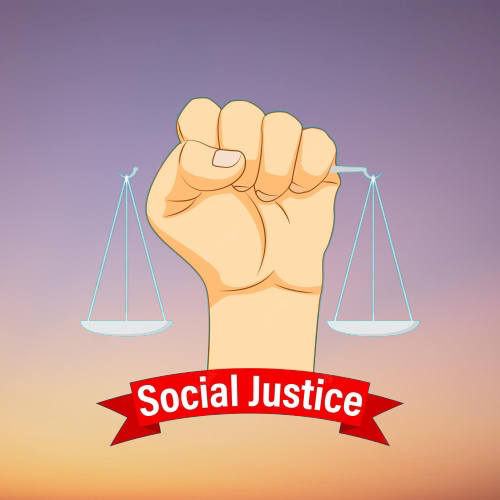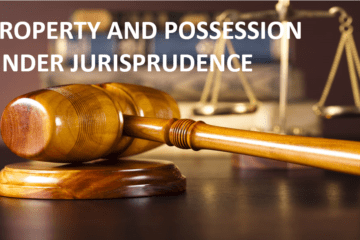
This article is written by Avantika Jain, an intern under Legal Vidhya
INTRODUCTION:
NATURAL JUSTICE:
Despite not being included in the Indian Constitution, the idea of natural justice is nonetheless seen as a crucial component of justice administration. Common law’s notion of “natural justice” finds its roots in the Latin term “Jus Natural,” which implies a natural law.
Natural justice is synonymous with fairness in a technical sense and signifies a “natural sense of right and wrong” in layman’s terms. Administrative discretion can be very broadly applied in natural justice. With an act of administrative authorities, it seeks to prevent arbitrary decision-making and unfairness towards the public.
Development of the principle of natural justice
Although the phrase “natural justice” is not used in the Indian Constitution, the concept of these rules is established in the Preamble as “social and economic justice,” which is described as “fairness in the society’s social and economic activities.” The Supreme Court reiterated that natural justice rules must be interpreted in combination with legal requirements and that this is essential if the rule forbids the use of natural justice principles.
The issue before the Supreme Court in Union of India vs. Tulsiram Patel [1]was the interpretation of Articles 309, 310, and 311 of the Indian Constitution, particularly after the Constitution (42nd Amendment) Act of 1976 changed Provision 2 of Article 311, the second proviso to that clause.
Despite the fact that the judgement addressed a service problem and the safeguards provided on people engaged in civil capacities under the Union of India or the State by Article 311 of the Constitution of India, the Supreme Court analysed the principles of natural justice in depth.
It has been said that the principles of natural justice are not the result of Article 14 of the Indian Constitution, but rather its Constitutional Guardian rather than their begetter. The Supreme Court traced the roots of the idea.
In the case of Tulsiram Patel, the Supreme Court considered how courts have interpreted natural justice principles and how far they should be stretched.
It was claimed that two rules embodying natural justice principles in the judicial process, including quasi-judicial and administrative processes, were formed through a judicial interpretation process.
They are as follows:
a. no one shall be a judge in his own cause;
b. hears the other side Audi Alteram Partem;
c. no one shall be a judge in his own cause;
d. no one shall be a judge in his own cause;
The preceding two criteria have drawn a corollary, namely that whoever decides anything without hearing the opposite side will not have done what is right, even though he may have stated what is correct. In other words, justice, as it is currently represented, should not only be done but also appear to be done.
The Hon’ble Supreme Court held in Canara Bank and others vs. Sri Debasis Das [2]and others that “Natural Justice” and “Audi Alteram Partem” had been extensively explored when examining the extent and breadth of the Canara Bank Officers Employees’ (behavior) Regulations 1976.
PRINCIPLES
Fundamentals of Natural Justice
Natural justice is divided into two principles under traditional English law, namely
Nemo judex in causa sua (rule against bias) and Audi alteram partem. (rule of fair hearing)
- Nemo judex in causa sua: It is Latin for impartial judgement. A deciding authority must be unbiased and neutral while making a decision in any matter, according to one of the fundamental tenets of natural justice. Thus, the principle states that a judge or other decision-making authority shall be disqualified from adjudicating any case when prejudice or partiality is suspected. It states that justice should be rendered and upheld in public as well.
The decision made by the authority shall not be executed or it shall remain void if it is discovered that the judge who is adjudicating any dispute has its own interest or some outcome derived from such case. It is stated that the best qualities for effective administration are objectivity and fairness. Human nature dictates that, in most cases, a person cannot decide objectively when he or she has an interest in the outcome since doing so is extremely unusual. When one practices impartiality, one can successfully use his or her thinking. Thus, the rule against bias eliminates the option of making biased decisions. Additionally, it guarantees public trust in a nation’s judicial system
“It is evident that economic interest, however slight, in a subject matter of the proceedings, would entirely disqualify a member from functioning as a judge,” Justice Gajendragadkar wrote in M/S Builders Supply Corporation v. The Union of India and others
- Audi alteram partem: it means “let the other side be heard as well” or “hear the other side.” The second most fundamental principle of natural justice states that no one should be sentenced without having been heard. When someone is the target of legal action and their rights or interests are at stake, they should be given the chance to defend themselves on an equal footing.
It grants the party the right to reply to the evidence brought against them and select the legal counsel they choose. The principles of natural justice constitute a fundamentally fair procedure between the parties when any adjudicating authority decides a disagreement between parties.
In Maneka Gandhi v. Union of India, [3]the Indian government seized the petitioner’s passport out of concern for the general welfare. Before taking the contested action, the petitioner received no chance. The order, according to the Supreme Court, violated natural justice principles.
- Reasoned Decision
The freedom to reason is an essential component of effective judicial review. It is the foundation of good management. This need to explain reasons for the judgement is a unique approach in administrative law, since before, quasi-judicial bodies were not required to do so. The job of’ reason’ in the legal system is to connect the dots between facts and conclusions; it assists in the development of precedents, which increases the system’s confidence. The justifications must be succinct, clear, compelling, and believable.
This attribute is based on two assumptions:
first, if the lower body has supplied acceptable reasons and the upper body confirms that choice, no more explanations are necessary; nevertheless, if the higher body changes the lower body’s judgment, reasons must be presented.
Second, if the upper body supports the lower body’s choice without offering appropriate grounds, the lower body is required to do so. In the case of Manab Kumar Mitra Vs. the State of Orissa[4], it was remarked that it was hard to tell whether there was any application of mind without reason. The reason is the order’s essence. The right to reason is a need for successful judicial review. The reason is presupposed by logic and collides with facts to produce real results.
SOCIAL JUSTICE:
The word “social justice” has its origins in Christian theology, with the earliest recorded use in the early 1840s in Luigi Taparelli’s Theoretical Treatise on Natural Law. Taparelli was an Italian Jesuit priest who wrote during the advent of the Risorgimento, a 19th-century Italian nationalist movement, and the discussions over Italy’s unification.
Taparelli’s notion of social justice was simply an application of justice to social affairs, and he believed that individuals should do what was right based on a moral idea based on natural theology and religion, and for most of its history, social justice has been a religious concept.
The ability of people to realise their goals and aspirations in society without interference from the state is a key component of social justice. Justice has historically been used to refer to a person’s obligation to carry out their responsibilities and functions as well as to receive the protection of the state.
When applied in a social context, it refers to creating institutions that would allow people to reach their full potential, which entails giving each person a chance to positively impact the community. In other contexts, social justice refers to the process through which the government intervenes to provide social security, healthcare systems, equality laws, and labour rights in order to facilitate human progress.
A HUMAN GEOGRAPHY PERSPECTIVE ON SOCIAL JUSTICE
Inspired by Young’s work, David Smith’s definition of social justice “expands beyond patterns distribution” and concern with “attributes that have immediate bearing on people’s well-being or the quality of their lives.” More specifically, Smith’s concept of social justice encompasses “both fairness and equity in the distribution of a range of attributes,” which he does not limit to material attributes or things, unlike Young. He, like Young, is primarily concerned with understanding how social inequality came to be in the first place. Smith, as a human geographer, connects social justice to legal systems and questions of human rights, ethics, and morality. Simultaneously, he calls into question current social and institutional structures, as well as their role in fostering a just or unjust society.
PRINCIPLES
While there is no single definition of social justice, the general ideals of inclusion and fairness are shared by most systems. They construct a set of ethical rules for a just society in order to attain those aims.
Among these principles are:
Access
One of the most fundamental concepts of social justice is equal access to social benefits. This maintains that all of society’s resources should be available to everyone equitably. Many social justice theorists, for example, think that everyone should have equal access to education, health care, and work prospects. This ideal may be upheld by public workers ensuring that everyone has access to these resources.
Equity
Equity is the notion that everyone should have equal opportunity to achieve, regardless of previous injustices or institutional prejudice. This might imply that resources are allocated in a way that addresses the unique needs of underserved groups or individuals.
Diversity
The idea of diversity states that government and corporate leaders should be broadly representative of the populations they serve. This means that not only should women and people of colour hold positions of authority, but minority populations should also be represented equally in public institutions. On a legislative level, this idea may imply anti-discrimination legislation or the provision of resources in many languages.
Gender Equality
Almost every country experiences gender inequality, whether in the form of salary disparities, glass ceilings, or other types of gender discrimination. Furthermore, women are more likely to be victims of violence or sexual assault. or risk losing reproductive rights. Gender equality has an impact on other rights as well, such as racial equality. Many social justice campaigners see this as a critical component of social transformation.
Equality for LGBTQ+ People
LGBTQ+ rights arose as a new concern for social justice campaigners in the twentieth century. LGBTQ+ people endure a high degree of violence and discrimination, and they may be refused access to healthcare or work.
LAW AND SOCIAL JUSTICE
Social justice concepts in law have been a flashpoint in the American culture wars. Critical race theory (CRT), a legal paradigm that actively strives to account for how racial stereotypes impact legal results, has sparked special controversy.
The phrase was used by American legal scholars such as Kimberlé Crenshaw to describe how racism is promoted through American legal frameworks, even in the absence of racist individuals in some circumstances. The premise that race is not validated by science and that the law has sustained an unfair system is central to CRT.
CRITICISM
Detractors of critical race theory contend that it is little more than a cover for prejudice. According to the Brookings Institute, a public policy thinks tank, critics of critical race theory see the claim that American institutions are racist as a way to accuse White people of being racist individually, rather than as an attempt at a broad analysis of the effect of institutions on social outcomes.
Campaigns against CRT have been increasingly loud in state legislatures across the United States, with several outlawing its use in elementary and secondary schools. According to a state legislative tracker developed by Chalkbeat, a nonprofit media focusing on the American education system, 36 states have moved to outlaw teaching on racial bias in the United States, while 17 have moved to extend such teaching.
President Donald Trump also prohibited diversity and equity training from government contracts in 2020, dubbed a “equity gag order.” The executive order confused diversity training and CRT, referring to both as “divisive.” The prohibition was lifted in 2021.
Difference between social and natural justice
| PARAMETERS | NATURAL JUSTICE | SOCIAL JUSTICE |
| DEFINITION | Natural justice refers to the concept of fairness that arises from basic principles of natural law, such as the right to a fair trial, the right to be heard, and the right to be judged impartially | social justice refers to the idea of fairness in terms of the distribution of wealth, opportunities, and privileges within a society. |
| APPLICATION | Natural justice is often seen as a universal and objective standard of justice that applies to all people regardless of their social, economic, or political status. | It recognizes that certain groups in society may face discrimination or disadvantage based on factors such as race, gender, or socio-economic status, and seeks to address these inequalities through policies and programs that promote equality and fairness. |
| FOCUS | Natural justice focuses on the rights of individuals and the procedural fairness of legal systems | social justice is concerned with addressing systemic inequalities and promoting the well-being of disadvantaged groups in society. |
| SIMILARITIES | Both concepts are important for promoting a just and equitable society, but they approach justice from different perspectives. | |
CONCLUSION:
To summarize, social justice and natural justice are both fundamental notions that play a crucial role in promoting societal fairness and equality. Natural justice focuses on guaranteeing fairness and due process in legal procedures, whereas social justice attempts to establish a more equitable distribution of money, opportunities, and resources.
Both types of justice are required for the development of a just and peaceful society in which everyone has equal possibilities to achieve and live a satisfying life. Achieving social and natural justice necessitates teamwork and a dedication to fairness and equality.
Individuals may contribute to social and natural justice by pushing for laws and practise that promote fairness and equality, treating others with dignity and compassion, and holding those in authority responsible for their actions. Only by working together can we build a society in which social and natural justice is preserved and everyone has a chance to prosper.
[1] 1985 AIR 1416, 1985 SCR Supl. (2) 131
[2] (2000) 2 CALLT 170 HC
[3] 1978 SCR (2) 621
[4] AIR 1997 Ori 52




0 Comments